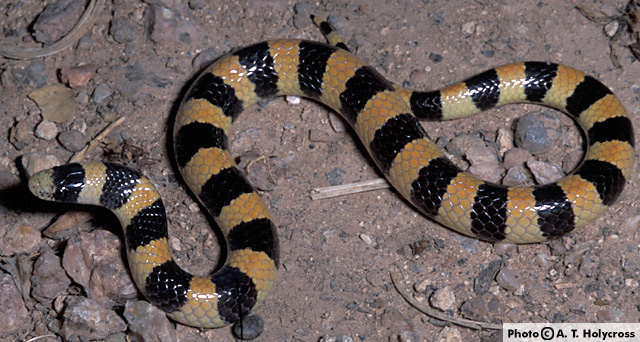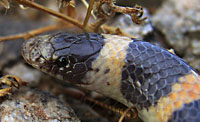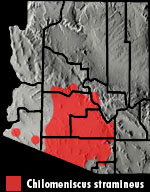Online Field Guide to The Reptiles and Amphibians of Arizona



Maricopa County, AZ
 Maricopa Co., AZ |
| VARIABLE SANDSNAKE Chilomeniscus stramineus |
Mildly Toxic Saliva
|
| DESCRIPTION: A small (up to 285 mm or 11″ in total length), stout-bodied snake with dark brown or black saddles on an orange dorsum. The orange dorsal coloration grades into cream on the lower sides. The black saddles do not cross the venter on the body but they completely encircle the tail. The belly is pale cream with no markings. The snout is white or light gray. A broad, black mask crosses the top of the head and covers the eyes. Adaptations for burrowing in fine gravel and sand include small eyes, valves in the nasal passages, a flat and wedge-like snout, a concaved belly, and a deeply inset jaw. The head is not distinct from the thick neck. The pupils are round and the scales are smooth and shiny. The often similar looking Groundsnake has a dark spot on the anterior edge of each lateral scale. The black saddles are in contact with orange-red dorsal coloration distinguishing this snake from the similar looking Western Shovel-nosed Snake.
DISTRIBUTION: This snake is found across most of south-central Arizona. Isolated populations in the southwestern portion of the state extend as far west as the vicinity of Ligurta in Yuma County. In Arizona this snake is found at elevations ranging from 200′ to 3,000′. HABITAT: The Variable Sandsnake is found primarily in the Arizona Upland subdivision of the Sonoran Desertscrub community. It is usually encountered above the flats in or near drainages and canyons with loose gravel or sand substrates. DIET: The Variable Sandsnake feeds on a variety of insects including roaches and grasshoppers. It also feeds on centipedes. REPRODUCTION: Mating probably takes place in spring. A clutch of up to 4 eggs is laid in summer. Bartlett. 2000. Snakes of North America: Western Region. Gulf Publishing Co. Houston, TX Brennan, T. C., and A. T. Holycross. 2006. A Field Guide to Amphibians and Reptiles in Arizona. Arizona Game and Fish Department. Phoenix, AZ Brennan, T. C., and A. T. Holycross. 2005. A Field Guide to Amphibians and Reptiles of Maricopa County. Arizona Game and Fish Department. Phoenix, AZ Fowlie. 1965. The Snakes of Arizona. Azul Quinta Press, Fallbrook, California Lowe, Schwalbe, Johnson. 1986. The Venomous Reptiles of Arizona. Nongame Branch Stebbins. 1985. Western Reptiles and Amphibians. Houghton Mifflin. New York, NY |
|
Visit Partners in Amphibian and Reptile Conservation:


HOME
Copyright © 2023, Arizona Game and Fish Department. All rights reserved.
If you make use of the textual contents of this site in reports, publications, etc. please cite and credit the author(s) and photographer(s). All photos on this website are copyrighted. However, those found in the species account section may be used for any noncommercial scientific, educational, or conservation purposes provided that photographs are not altered and continue to bear the copyright symbol and name of the photographer. Please contact the photographer regarding commercial use of copyrighted photographs.










